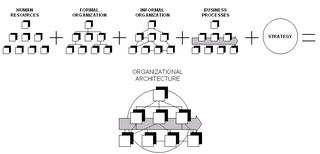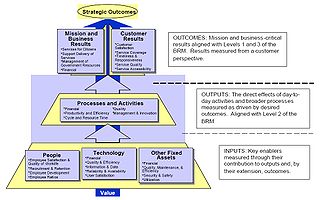
Enterprise resource planning (ERP) is the integrated management of main business processes, often in real time and mediated by software and technology. ERP is usually referred to as a category of business management software—typically a suite of integrated applications—that an organization can use to collect, store, manage and interpret data from many business activities. ERP systems can be local-based or cloud-based. Cloud-based applications have grown in recent years due to the increased efficiencies arising from information being readily available from any location with Internet access.

A business plan is a formal written document containing the goals of a business, the methods for attaining those goals, and the time-frame for the achievement of the goals. It also describes the nature of the business, background information on the organization, the organization's financial projections, and the strategies it intends to implement to achieve the stated targets. In its entirety, this document serves as a road-map that provides direction to the business.
Strategic planning is an organization's process of defining its strategy or direction, and making decisions on allocating its resources to attain strategic goals.
In the field of management, strategic management involves the formulation and implementation of the major goals and initiatives taken by an organization's managers on behalf of stakeholders, based on consideration of resources and an assessment of the internal and external environments in which the organization operates. Strategic management provides overall direction to an enterprise and involves specifying the organization's objectives, developing policies and plans to achieve those objectives, and then allocating resources to implement the plans. Academics and practicing managers have developed numerous models and frameworks to assist in strategic decision-making in the context of complex environments and competitive dynamics. Strategic management is not static in nature; the models can include a feedback loop to monitor execution and to inform the next round of planning.

A performance indicator or key performance indicator (KPI) is a type of performance measurement. KPIs evaluate the success of an organization or of a particular activity in which it engages. KPIs provide a focus for strategic and operational improvement, create an analytical basis for decision making and help focus attention on what matters most.
Stages-of-growth model is a theoretical model for the growth of information technology (IT) in a business or similar organization. It was developed by Richard L. Nolan during the early 1970s, and with the final version of the model published by him in the Harvard Business Review in 1979.
A business case captures the reasoning for initiating a project or task. Many projects, but not all, are initiated by using a business case. It is often presented in a well-structured written document, but may also come in the form of a short verbal agreement or presentation. The logic of the business case is that, whenever resources such as money or effort are consumed, they should be in support of a specific business need. An example could be that a software upgrade might improve system performance, but the "business case" is that better performance would improve customer satisfaction, require less task processing time, or reduce system maintenance costs. A compelling business case adequately captures both the quantifiable and non-quantifiable characteristics of a proposed project. According to the Project Management Institute, a business case is a "value proposition for a proposed project that may include financial and nonfinancial benefit."

Business process re-engineering (BPR) is a business management strategy originally pioneered in the early 1990s, focusing on the analysis and design of workflows and business processes within an organization. BPR aims to help organizations fundamentally rethink how they do their work in order to improve customer service, cut operational costs, and become world-class competitors.
An action plan is a detailed plan outlining actions needed to reach one or more goals. Alternatively, it can be defined as a "sequence of steps that must be taken, or activities that must be performed well, for a strategy to succeed".
In management, business value is an informal term that includes all forms of value that determine the health and well-being of the firm in the long run. Business value expands concept of value of the firm beyond economic value to include other forms of value such as employee value, customer value, supplier value, channel partner value, alliance partner value, managerial value, and societal value. Many of these forms of value are not directly measured in monetary terms. According to the Project Management Institute, business value is the "net quantifiable benefit derived from a business endeavor that may be tangible, intangible, or both."

Organizational architecture, also known as organizational design, is a field concerned with the creation of roles, processes, and formal reporting relationships in an organization. It refers to architecture metaphorically, as a structure which fleshes out the organizations. The various features of a business's organizational architecture has to be internally consistent in strategy, architecture and competitive environment.

Demand-chain management (DCM) is the management of relationships between suppliers and customers to deliver the best value to the customer at the least cost to the demand chain as a whole. Demand-chain management is similar to supply-chain management but with special regard to the customers.

Performance measurement is the process of collecting, analyzing and/or reporting information regarding the performance of an individual, group, organization, system or component.
The following outline is provided as an overview of and topical guide to business management:
In marketing, a company’s value proposition is the full mix of benefits or economic value which it promises to deliver to the current and future customers who will buy their products and/or services. It is part of a company's overall marketing strategy which differentiates its brand and fully positions it in the market. A value proposition can apply to an entire organization, parts thereof, customer accounts, or products and services.
Change management (CM) is a collective term for all approaches to prepare, support, and help individuals, teams, and organizations in making organizational change. It includes methods that redirect or redefine the use of resources, business process, budget allocations, or other modes of operation that significantly change a company or organization.
Post-merger integration or PMI is the process of combining and rearranging businesses to materialize potential efficiencies and synergies that usually motivate mergers and acquisitions. The PMI is a critical aspect of mergers; it involves combining the original logistical-socio-technical systems of the merging organizations into one newly combined system.
A competency architecture is a framework or model of predetermined skills or "competencies" used in an educational setting. Competency architectures are a core component of competency-based learning.
Human resource planning is a process that identifies current and future human resources needs for an organization to achieve its goals. Human resource planning should serve as a link between human resource management and the overall strategic plan of an organization. Ageing workers population in most western countries and growing demands for qualified workers in developing economies have underscored the importance of effective human resource planning.
The high performance organization (HPO) is a conceptual framework for organizations that leads to improved, sustainable organizational performance. It is an alternative model to the bureaucratic model known as Taylorism. There is not a clear definition of the high performance organization, but research shows that organizations that fit this model all hold a common set of characteristics. Chief among these is the ability to recognize the need to adapt to the surroundings that the organization operates in. High performance organizations can quickly and efficiently change their operating structure and practices to meet needs. These organizations focus on long term success while delivering on actionable short term goals. These organizations are flexible, customer focused, and able to work highly effectively in teams. The culture and management of these organizations support flatter hierarchies, teamwork, diversity, and adaptability to the environment which are all of paramount success to this type of organization. Compared to other organizations, high performance organizations spend much more time on continuously improving their core capabilities and invest in their workforce, leading to increased growth and performance. High performance organizations are sometimes labeled as high commitment organizations.







